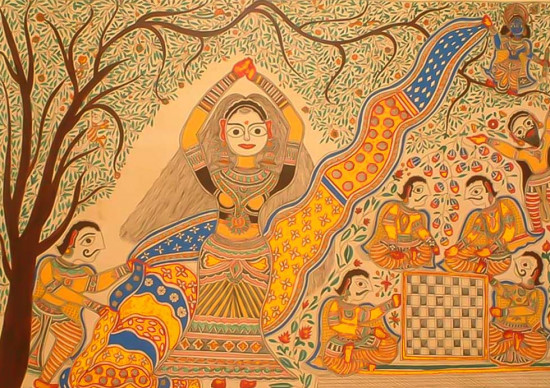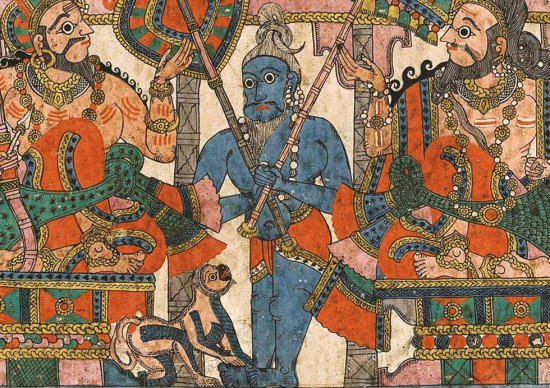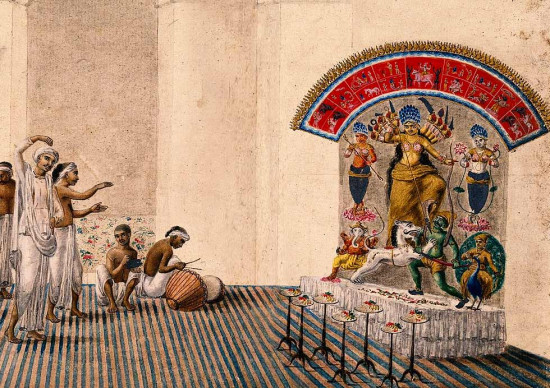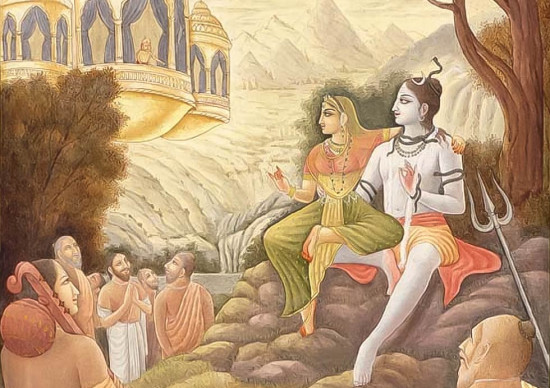या देवी सर्वभुतेषु बुद्धिरूपेण संस्थितानमस्तस्यै नमस्तस्यै नमस्तस्यै नमो नमः
O Goddess, may your power be present in every being in the world. O Goddess, I bow to you repeatedly. O Goddess, may your strength be manifested in every living being in the world. O Goddess, we bow to you again and again.
Goddess Durga, the embodiment of Shakti, nature, love, courage, and motherhood. Maa Durga is the epitome of strength and grace. Revered as Mother of the Universe, she nurtures and protects. Fierce yet graceful, she vanquishes evil as Mahishasurmardini. Durga’s love shines through her strength, inspiring courage and wisdom. Goddess Durga gracefully rides a majestic lion, adorned in a vibrant red saree and adorned with exquisite ornaments. Her ten arms skillfully wield a diverse array of weapons, showcasing her divine prowess and protective might. Today we know the Significance of Iconography of 10-armed Durga.
O Goddess, may your power be present in every being in the world. O Goddess, I bow to you repeatedly. O Goddess, may your strength be manifested in every living being in the world. O Goddess, we bow to you again and again.
Goddess Durga, the embodiment of Shakti, nature, love, courage, and motherhood. Maa Durga is the epitome of strength and grace. Revered as Mother of the Universe, she nurtures and protects. Fierce yet graceful, she vanquishes evil as Mahishasurmardini. Durga’s love shines through her strength, inspiring courage and wisdom. Goddess Durga gracefully rides a majestic lion, adorned in a vibrant red saree and adorned with exquisite ornaments. Her ten arms skillfully wield a diverse array of weapons, showcasing her divine prowess and protective might. Today we know the Significance of Iconography of 10-armed Durga.
Significance of Iconography of 10-armed Durga
The iconography of the 10-armed Durga holds profound significance in Hindu mythology, representing the goddess’s multifaceted divine attributes. Each element of this visual representation carries symbolic weight, contributing to the broader understanding of Durga’s role and power. Explore the deeper meaning behind her ten arms, each adorned with distinctive weapons, as well as the symbolism of her posture, attire, and accompanying lion. Delve into the layers of iconography to unveil the rich tapestry of spiritual and cosmic meanings embedded in the visual representation of Goddess Durga.
The 10 arms of Goddess Durga in Hindu iconography symbolize her immense power, versatility, and ability to multitask in her cosmic role. Each arm carries a unique weapon, emphasizing different aspects of her divine authority. Here’s a detailed exploration of the symbolism behind the ten arms:
The 10 arms of Goddess Durga in Hindu iconography symbolize her immense power, versatility, and ability to multitask in her cosmic role. Each arm carries a unique weapon, emphasizing different aspects of her divine authority. Here’s a detailed exploration of the symbolism behind the ten arms:
-Trident (Trishul): Represents control over the three gunas (qualities) of nature—sattva (goodness), rajas (passion), and tamas (ignorance).
-Sword (Khadga): Symbolizes the sharpness of intellect and the ability to cut through ignorance and duality.
-Conch Shell (Shankha): Signifies the primordial sound Aum, representing the creation of the universe.
-Discus (Chakra): Symbol of the eternal wheel of time, emphasizing the cyclical nature of existence.
-Bow (Dhanush): Represents determination and the ability to focus the mind on a single point.
-Arrow (Ban): Symbol of the pursuit of righteousness and the ability to eradicate evil.
-Lotus (Padma): Represents purity, spiritual power, and the unfolding of divine qualities.
-Mace (Gada): Symbolizes the power to crush ignorance and overcome obstacles.
-Javelin (Bharji): Represents the piercing force of truth and the ability to penetrate illusions.
-Shield (Khetaka): Symbolizes protection and the ability to ward off negative forces.
The variety of weapons in Durga’s hands illustrates her readiness to combat different challenges on various levels, both physical and metaphysical. The arms collectively convey the idea of balance, strength, and the ability to uphold cosmic order. The choice of each weapon reflects a specific aspect of her cosmic duties, contributing to the overall narrative of her divine role as a protector, nurturer, and cosmic force.









